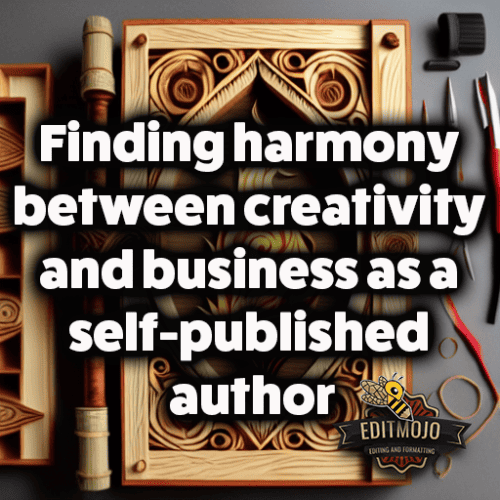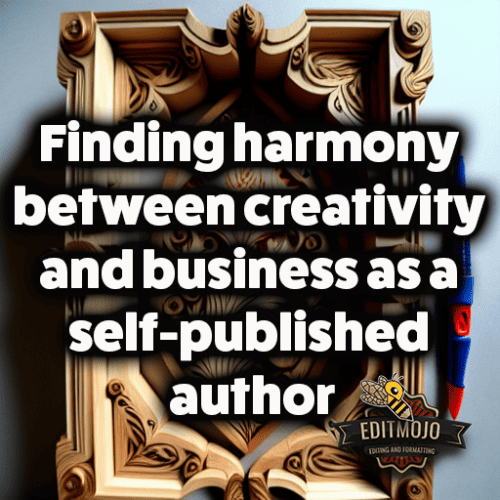Finding harmony between creativity and business as a self-published author
Finding harmony between creativity and business as a self-published author. As a writer, you’ve most likely envisioned your masterpiece gracing the shelves of bookstores worldwide. Traditionally, this dream involved sending manuscripts to countless publishing houses and praying for an acceptance letter. However, with the rise of the digital age, the publishing landscape has drastically shifted. Self-publishing, once seen as a last resort, has become a legitimate and oftentimes preferable path to success. But, in the journey of self-publishing, authors must balance two contrasting worlds: the realm of creativity and the domain of business. This post aims to serve as a comprehensive guide to help you navigate these dual aspects and achieve harmony between your creative desires and business necessities.
Key Takeaways
| Topic | Key Takeaways |
|---|---|
| The Changing Landscape of Publishing | Self-publishing, enabled by platforms like Amazon Kindle Direct Publishing and Smashwords, has become a viable and successful method for authors to share their work. |
| Understanding Creativity and Business | Both creative and business aspects are crucial in self-publishing. Authors need to be equally invested in generating ideas, writing, editing, and revising as well as marketing, networking, and managing finances. |
| Strategies to Maintain Creativity | Understanding your creative process, keeping creativity alive through various means, overcoming creative blocks, and seeking feedback can enhance your writing. |
| Decoding the Business of Self-Publishing | Essential business skills, understanding the market, and leveraging technology are necessary for the business side of self-publishing. |
| Balancing Creativity and Business | Time management, delegating tasks, and embracing the dual role of an author and an entrepreneur can help in balancing the two aspects. |
| Common Mistakes and How to Avoid Them | Overemphasizing either creativity or business, mistakes in DIY marketing, and neglecting self-care can hinder your progress. |
| Insights from Successful Self-Published Authors | Learning from successful authors can offer valuable insights into the self-publishing process. |
The Changing Landscape of Publishing
Before diving into how to find this elusive balance, let’s briefly touch upon the publishing landscape. Traditionally, publishing houses were the gatekeepers of literature, deciding what readers got to consume. However, with the advent of self-publishing platforms like Amazon Kindle Direct Publishing and Smashwords, the power has shifted into the hands of authors. Now, you can directly share your work with the world, without any intermediary.
And it’s not just an emerging trend, but a powerful one. Hugh Howey, author of the bestselling ‘Wool’ series, started as a self-published author and has since sold millions of copies worldwide. This is just one of many success stories that demonstrate the potential of self-publishing.

Understanding the Nature of Creativity and Business in Self-Publishing
In the world of self-publishing, creativity and business are two sides of the same coin. On one hand, you have the creative process—the birthplace of ideas, the art of crafting characters, plots, and worlds, and the rigorous task of editing and revising. On the other hand, you have the business aspect—marketing your book, building a network, managing finances, understanding contracts, and staying updated with the market trends. Balancing these two aspects can be challenging but necessary for success.
Strategies to Ignite and Maintain Creativity
As a writer, creativity is your bread and butter. It’s what brings your stories to life and engages your readers. But, as any artist knows, creativity isn’t always a constant companion. Sometimes, it needs a little nudge.
- Understand your creative process: Everyone has their own unique way of generating and developing ideas. Some authors swear by daily writing, while others advocate for the “burstiness” of creative output—intense periods of productivity interspersed with periods of rest.
- Keep the creative juices flowing: This could be through writing rituals, attending workshops, or joining writing groups.
- Overcome creative blocks: You might find solutions in a change of environment, physical activity, or simply giving yourself permission to write badly.
- Seek feedback and criticism: Constructive feedback, whether from a writing group or a professional editor, can help improve your writing and storytelling skills.
Decoding the Business of Self-Publishing
The business side of self-publishing, while not as romantic as the creative process, is equally important. It’s what gets your book in the hands of your readers.
- Acquire basic business skills: Understanding basic accounting, marketing, and contract negotiation can be hugely beneficial. There are plenty of [free resources online](https://www.c
oursera.org/courses?query=business%20basics) to help you learn these skills.
- Understand the market: Who is your target audience? What are the current market trends? Answers to these questions can inform your writing and marketing strategy.
- Leverage technology: There are various tools and platforms to help you manage your business. From social media platforms for marketing to accounting software for managing finances, technology can be a powerful ally.

Balancing Creativity and Business: Practical Steps
The key to striking a balance between creativity and business is to treat both with equal importance.
- Manage your time wisely: Allocate dedicated time for your creative activities and your business tasks.
- Consider delegating tasks: If the business side of things gets overwhelming, consider hiring a freelancer or a part-time professional.
- Embrace both roles: You’re not just a writer; you’re an entrepreneur. Embracing this mindset can make navigating the business aspects less daunting.
Common Mistakes and How to Avoid Them
In your self-publishing journey, you’re bound to make mistakes. That’s part of the process. However, some common pitfalls can be avoided:
- Overemphasis on either creativity or business: Both are vital for your success as a self-published author. Ignoring one for the other can lead to either a great book that no one reads or a well-marketed book that doesn’t meet readers’ expectations.
- DIY marketing mistakes: Not all marketing strategies are created equal. What works for one author might not work for you. It’s essential to understand your audience and tailor your strategy accordingly.
- Burnout: The journey of self-publishing is a marathon, not a sprint. It’s important to take breaks and allow yourself to recharge.
Insights from Successful Self-Published Authors
Learning from those who’ve walked the path before you can be incredibly insightful. Authors like Amanda Hocking and E.L. James, who started their journeys as self-published authors, emphasize the importance of understanding your audience, the power of social media marketing, and the need for persistence and resilience.
Conclusion (Finding harmony between creativity and business as a self-published author)
Balancing creativity and business in self-publishing might seem like a herculean task, but remember, you’re aiming for balance, not perfection. And when you find that sweet spot, you’ll realize the rewards of self-publishing are well worth the effort.

Additional Resources
Interested in diving deeper? Check out these resources on self-publishing, creativity, and business management:
- Books: On Writing by Stephen King, The Business of Being a Writer by Jane Friedman
- Courses: Self-Publishing 101 on Udemy, Business Basics for Entrepreneurs on Coursera
- Forums: Kboards, Reddit’s Selfpublish
Invitation for Feedback and Discussion (Finding harmony between creativity and business as a self-published author)
Now it’s your turn. What has been your experience in balancing creativity and business as a self-published author? What challenges have you faced and how did you overcome them? Share your thoughts in the comments section below and let’s start a conversation!
Top Five Questions and Answers
| Question | Answer |
|---|---|
| Why is it important to balance creativity and business in self-publishing? | Both aspects are essential in the self-publishing journey. While creativity is required for content creation, business acumen ensures that the work reaches the audience and generates revenue. |
| How can I keep my creativity flowing as a writer? | Understand your unique creative process, adopt rituals or practices that foster creativity, engage in activities to overcome blocks, and be open to feedback and criticism. |
| What business skills are important for self-publishing? | Essential business skills for self-publishing include understanding basic accounting, marketing, contract negotiation, and market trends. Utilizing technology can also ease business management. |
| What are some common mistakes self-published authors make? | Common mistakes include overemphasizing either creativity or business, making errors in DIY marketing, and neglecting self-care, which can lead to burnout. |
| Where can I learn from successful self-published authors? | Interviews, articles, and biographies of successful self-published authors can offer insights. Online forums and communities also provide platforms for shared experiences and discussions. |
Finding harmony between creativity and business as a self-published author
